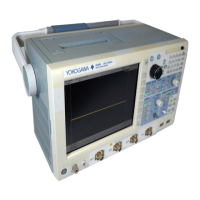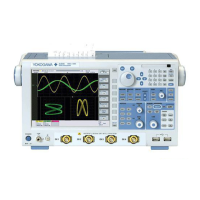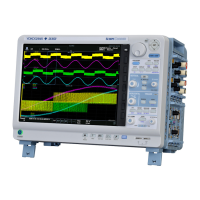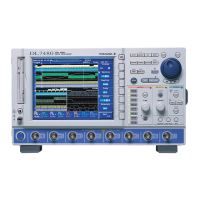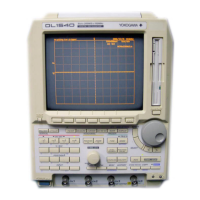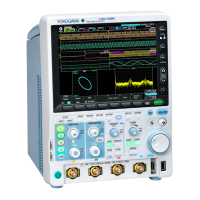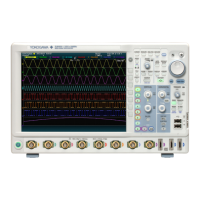
Do you have a question about the YOKOGAWA DL9040L and is the answer not in the manual?
| Brand | YOKOGAWA |
|---|---|
| Model | DL9040L |
| Category | Test Equipment |
| Language | English |
Describes the top, front, and rear panels of the DL9000 instrument.
Details trigger sources, slopes, levels, and types for waveform acquisition.
Explains acquisition modes like Normal, Envelope, and Averaging.
Explains cursor measurements, automated parameter measurement, and signal searching.
Provides essential safety and handling precautions for instrument operation.
Details installation conditions, including environment and physical placement.
Explains the procedure for safely connecting the instrument to a power source.
Guides on connecting probes and measurement input cables to the instrument.
Describes the process for phase correction of the probe for accurate measurements.
Explains how to use front panel keys and the rotary knob for menu operations.
Describes how to restore factory default settings or cancel initialization.
Explains the auto setup function for automatically setting appropriate signal parameters.
Explains how to start and stop signal acquisition using the START/STOP key.
Details the process of performing instrument calibration for accuracy.
Covers selecting input coupling methods (AC, DC, GND, DC50) for signals.
Guides on setting the probe attenuation ratio for correct voltage measurements.
Describes setting the V/div (voltage sensitivity) for waveform amplitude adjustment.
Explains how to set the time axis scale (T/div) for waveform display.
Guides on performing automatic zero adjustment for current probes.
Explains trigger modes like Auto, Normal, Single, and N Single for waveform updates.
Guides on setting the trigger position and its relation to delay time.
Details setting trigger delay by time, first edge, or edge count.
Explains how to prevent triggering for a specified time after a trigger occurrence.
Covers setting trigger coupling, HF rejection, hysteresis, and window comparator.
Guides on activating edge triggers based on signal level passing the trigger level.
Explains triggering on serial bus signals like I2C, CAN, LIN, SPI, UART.
Describes acquisition modes like Normal, Envelope, and Averaging.
Explains setting actions (buzzer, print, save, mail) to be triggered by events.
Guides on setting actions based on GO/NO-GO determination results.
Details setting GO/NO-GO conditions based on waveform zones.
Describes waveform zooming in time and voltage axes, including zoom position and link.
Guides on setting up computation channels, selecting operators, units, and display ranges.
Guides on using various cursor types (Vertical, Horizontal, H&V, VT, Marker, Serial) for measurements.
Explains automated measurement of parameters like Max, Min, Rise, Fall, and more.
Guides on performing mask tests and eye pattern measurements for telecom signals.
Details performing Fast Fourier Transform (FFT) and analyzing the power spectrum.
Covers selecting search types, skip modes, executing searches, and viewing results.
Describes displaying previously acquired waveforms stored in history memory.
Guides on connecting USB storage devices for data transfer and storage.
Guides on saving and loading instrument setup configurations to storage media.
Details saving and loading measurement data (ACQ Memory, ASCII, Float).
Details connecting the DL9000 to a PC via USB for control and data transfer.
Details connecting the DL9000 to a PC or network via Ethernet.
Guides on configuring TCP/IP settings for network communication.
Details monitoring and controlling the DL9000 via a PC web browser.
Describes the external trigger input connector and its specifications.
Explains the GO/NO-GO signal output connector and its logic levels.
Provides a table of common faults, probable causes, and corrective actions.
Lists information, file, execution, setting, and system error messages with actions.
Guides on performing self-tests for memory, printer, PC card, keys, and accuracy.
Details specifications for input channels, coupling, impedance, and voltage ranges.
Provides detailed specifications for trigger modes, sources, coupling, and levels.
Details specifications for PC card, USB, and Ethernet interfaces.
